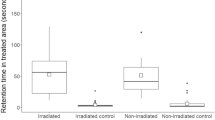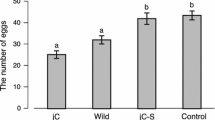Summary
Modelling studies are presented which describe the effect of lek mating on the control of a wild population by sterile male release. The mixed leks are assumed to follow a Poisson-binomial distribution and the system includes three parts: territory defense, matings inside a lek and matings outside a lek. The effects of parameters on the hatchability are discussed. Among the parameters, sterile type effect (W s ), female choice (f s ) and mating competitiveness (C m ) are the most important. The application to determining the effects of sterile male release and on the proportion of sterile males required for eradication are also discussed.
Similar content being viewed by others
References
Arita, L. H. and K. Y. Kaneshiro (1985) The dynamics of the lek system and mating success in males of the Mediterranean fruit fly,Ceratitis capitata (Wiedemann).Proc. Hawaii. Entomol. Soc. 25: 39–48.
Barclay, H. J. and M. Mackauer (1980a) The sterile insect release method for pest control: a densitydependent model.Environ. Entomol. 9: 810–817.
Barclay, H. J. and M. Mackauer (1980b) Effects of sterile insect releases on a population under predation or parasitism.Res. Popul. Ecol. 22: 136–146.
Berryman, A. A. (1967) Mathematical description of the sterile male principle.Can. Entomol. 99: 858–865.
Berryman, A. A., Bogyo, T. P., and L. C. Dickmann (1973) Computer simulation of population reduction by release of sterile insects: II. The effects of dynamic survival and multiple mating. InIAEA-PL-466/1 (pp. 31–43). Viennan: IAEA.
Bogyo, T. P., A. A. Berryman, and T. A. Sweeney (1971) Computer simulation of population reduction by release of sterile insects: I. A Study of the relative importance of the parameters of a mathematical model. 19–25. InApplication of induced sterility for control of Lepidopterous populations. Vienna: IAEA.
Burk, T. (1983) Behaviorl ecology of mating in the Caribbean fruit fly,Anastrepha suspensa (Loew).Fl. Entomol. 66: 330–334.
Burk, T. (1984) Male-male interactions in Caribbean fruit flies,Anastrepha suspensa (Loew) (Diptera: Tephritidae): territorial fights and signalling stimulation.Fl. Entomol. 67: 542–548.
Burk, T., and J. C. Webb (1983) Effect of male size on calling propensity, song parameters, and mating success in Caribbean fruit flies,Anastrepha suspensa (Loew) (Diptera; Tephritidae).Ann. Entomol. Soc. Am. 76: 678–682.
Calkins, C. O., D. L. Chambers and E. F. Bolier (1982) Quality control of fruit flies in a sterile insect release program. 341–55. InSterile insect technique and radiation in insect control, Int. Atomic Energy Agency, Vienna.
Calkins, C. O. (1984) The importance of understanding fruits fly mating behavior in sterile male release programs (Diptera, Tephritidae).Folia Entomol. Mexic. 61: 205–213.
Chambers, D. L. (1977) Quality control in mass rearing.Annu. Rev. Entomol. 22: 289–308.
Geier, P. W. (1969). Demographic models of population response to sterile-release procedures for pest control. 33–41. InInsect ecology and the sterile-male technique. Vienna: IAEA.
Gilmore, J. E. (1989) Sterile insect technique (SIT). 353–363. In A. S. Robinson and G. Hooper (eds)Fruit flies: their biology, natural enemies and control. Amsterdam: Elsevier.
Harrison, G. W., H. J. Barclay, and P. Driessche (1982) Analysis of a sterile insect release model with predation.Math. Biol. 16: 33–48.
Hendrichs, J. P. (1986) Sexual selection in wild and sterile Caribbean fruit flies,Anastrepha suspensa (Loew) (Diptera, Tephritidae). M.S. thesis, University of Florida. 263pp.
Huettel, M. D. (1976) Monitoring the quality of laboratory-reared insect: a biological and behavioral perspective.Environ. Entomol. 4: 801–807.
Ito, Y. (1977) A model of sterile insect release for eradication of the melon fly.,Dacus cucurbitae Coquillett.Appl. Ent. Zool. 12: 303–312.
Ito, Y., and H. Kawamoto (1979) Number of generations necessary to attain eradication of an insect pest with sterile insect release method: A model study.Res. Popul. Ecol. 20: 216–226.
Ito, Y., S. Miyai, and R. Hamada (1989) Modelling systems in relation to control strategies. 267–279. In A. S. Robinson and G. Hooper (eds)Fruit flies: their biology, natural enemies and control. Amsterdam: Elsevier.
Knipling, E. F. (1955) Possibilities of insect control or eradication through the use of sexually sterile males.J. Econ. Entomol. 48: 459–462.
Mazomenos, B., J. L. Nation, W. J. Coleman, K. C. Dennis and R. Esponda (1977) Reproduction in Caribbean fruit flies: comparisons between a laboratory strain and a wild strain.Fl. Entomol. 60: 139–144.
Plant, R. E. (1986) The sterile insect technique: a theoretical perspective. 361–386. In M. Mangel et al. (Eds)Pest control: operations and systems analysis in fruit fly management. Berlin: Springer-Verlag.
Sharp, J. L. and J. C. Webb (1977) Flight performance and signalling sound of irradicated or unirradiatedAnastrepha suspensa.Proc. Hawaii Entomol. Soc. 22: 525–532.
Sivinski, J., and T. Burk (1989) Reproductive and Mating Behaviour. 343–351 In A. S. Robinson and G. Hooper (eds)Fruit flies: their biology, natural enemies and control. Amsterdam: Elsevier.
Sivinski, J., and R. R. Heath (1988) Effects of oviposition on remating, response to pheromones, and longevity in the female Caribbean fruit fly,Anastrepha suspensa (Diptera: Tephritidae).Ann. Entomol. Soc. Am. 81: 1021–1024.
Smith, D. C., and R. J. Prokopy (1980) Mating behavior ofRhagoletis pomonella (Diptera: Tephritidae) VI. Site of early-season encounters.Can. Entomol. 112: 585–590.
Webb, J. C., J. Sivinski, and B. Smittle (1985) Acoustical courtship signals and several success in irradiated caribflyAnastrepha suspensa (Loew) (Diptera: Tephitidae).Fl. Entomol. 70: 103–109.
Author information
Authors and Affiliations
Rights and permissions
About this article
Cite this article
Horng, SB., Plant, R.E. Impact of lek mating on the sterile insect technique: A modeling study. Res Popul Ecol 34, 57–76 (1992). https://doi.org/10.1007/BF02513522
Issue Date:
DOI: https://doi.org/10.1007/BF02513522




